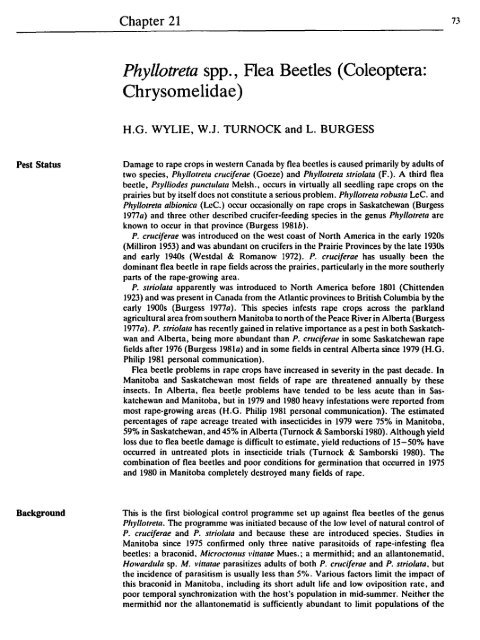pdf, 57.71Mb - Entomological Society of Canada
pdf, 57.71Mb - Entomological Society of Canada
pdf, 57.71Mb - Entomological Society of Canada
Create successful ePaper yourself
Turn your PDF publications into a flip-book with our unique Google optimized e-Paper software.
Pest Status<br />
Background<br />
Chapter 21<br />
Phyllotreta spp., Flea Beetles (Coleoptera:<br />
Chrysomelidae)<br />
H.G. WYLIE, W.l. TURNOCK and L. BURGESS<br />
Damage to rape crops in western <strong>Canada</strong> by flea beetles is caused primarily by adults <strong>of</strong><br />
two species, Phy/lotreta crllciferae (Goeze) and Phyl/otreta strio/ata (F.). A third flea<br />
beetle, Psylliodes puncru/ata Melsh., occurs in virtually all seedling rape crops on the<br />
prairies but by itself does not constitute a serious problem. Phyllolrela robusta Lee. and<br />
Phyllolrela a/bionica (Lee.) occur occasionally on rape crops in Saskatchewan (Burgess<br />
1977a) and three other described crucifer-feeding species in the genus Phyllotreta are<br />
known to occur in that province (Burgess 1981b).<br />
P. cruciferae was introduced on the west coast <strong>of</strong> North America in the early 1920s<br />
(Milliron 1953) and was abundant on crucifers in the Prairie Provinces by the late 1930s<br />
and early 1940s (Westdal & Romanow 1972). P. cruciferae has usually been the<br />
dominant flea beetle in rape fields across the prairies, particularly in the more southerly<br />
parts <strong>of</strong> the rape-growing area.<br />
P. slrio/ala apparently was introduced to North America before 1801 (Chittenden<br />
1923) and was present in <strong>Canada</strong> from the Atlantic provinces to British Columbia by the<br />
early 1900s (Burgess 1977a). This species infests rape crops across the parkland<br />
agricultural area from southern Manitoba to north <strong>of</strong> the Peace River in Alberta (Burgess<br />
1977a). P. strio/ata has recently gained in relative importance as a pest in both Saskatchwan<br />
and Alberta, being more abundant than P. cruciferae in some Saskatchewan rape<br />
fields after 1976 (Burgess 1981a) and in some fields in central Alberta since 1979 (H.G.<br />
Philip 1981 personal communication).<br />
Flea beetle problems in rape crops have increased in severity in the past decade. In<br />
Manitoba and Saskatchewan most fields <strong>of</strong> rape are threatened annually by these<br />
insects. In Alberta, flea beetle problems have tended to be less acute than in Saskatchewan<br />
and Manitoba, but in 1979 and 1980 heavy infestations were reported from<br />
most rape-growing areas (H.G. Philip 1981 personal communication). The estimated<br />
percentages <strong>of</strong> rape acreage treated with insecticides in 1979 were 75% in Manitoba,<br />
59% in Saskatchewan, and 45% in Alberta (Turnock & Samborski 1980). Although yield<br />
loss due to flea beetle damage is difficult to estimate. yield reductions <strong>of</strong> 15-50% have<br />
occurred in untreated plots in insecticide trials (Turnock & Samborski 1980). The<br />
combination <strong>of</strong> flea beetles and poor conditions for germination that occurred in 1975<br />
and 1980 in Manitoba completely destroyed many fields <strong>of</strong> rape.<br />
This is the first biological control programme set up against flea beetles <strong>of</strong> the genus<br />
Phyllotreta. The programme was initiated because <strong>of</strong> the low level <strong>of</strong> natural control <strong>of</strong><br />
P. cruciferae and P. strio/ata and because these are introduced species. Studies in<br />
Manitoba since 1975 confirmed only three native parasitoids <strong>of</strong> rape-infesting flea<br />
beetles: a braconid. Microctonus \'ittatae Mues.; a mermithid; and an allantonematid.<br />
Howardu/a sp. M. viltatae parasitizes adults <strong>of</strong> both P. cruciferae and P. strio/ala. but<br />
the incidence <strong>of</strong> parasitism is usually less than 5%. Various factors limit the impact <strong>of</strong><br />
this braconid in Manitoba. including its short adult life and low oviposition rate. and<br />
poor temporal synchronization with the host's population in mid-summer. Neither the<br />
mermithid nor the allantonematid is sufficiently abundant to limit populations <strong>of</strong> the<br />
73
















